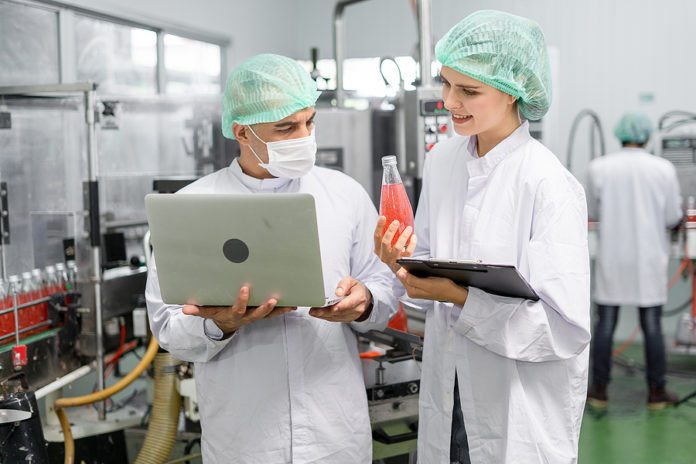

Inflation, labor shortages, supply chain disruptions, changing consumer expectations, sustainability mandates – the list of challenges facing the food and beverage industry is significant and seems to be constantly growing. The good news is that there is a step that food and beverage companies – whether they’re processors, manufacturers, or distributors – can take to help alleviate all of these challenges: digital transformation.

Jack Payne has been advising food and beverage companies about their technology for over 25 years. He has been part of the evolution in manufacturing from material requirements planning (MRP) to manufacturing resource planning (MRP II) to enterprise resource planning (ERP), and from on-premises software to cloud platforms and mobile apps. He is currently the Solution Consulting Director, Food & Beverage and Process Manufacturing at Aptean, a software provider with solutions that span the entire food and beverage supply chain, from ERP to overall equipment effectiveness (OEE), enterprise asset management (EAM), transportation management, and more.
Aptean recently commissioned a survey and whitepaper from IDC on Global Food and Beverage Industry Trends and Strategic Insights 2022. I sat down with Jack to discuss the results. This two-part series of articles presents an edited version of our conversation: Part 1 provides an overview of the current and future state of digital transformation in the food industry, and Part 2 digs into factors surrounding the selection of an ERP system, the technology that forms the foundation of any digital transformation initiative.
To hear more about trends, challenges and opportunities, and insights to drive your decision-making in 2023, register for Aptean’s webinar on December 15.
This is your third year of doing this survey. What were you hoping to uncover?
Jack Payne: The pandemic brought a whole new set of challenges for the food and beverage industry. For example, prior to the pandemic, I think the average individual had never heard the word supply chain. Now, it’s common knowledge.
We started doing these reports in 2020 with the goal of understanding how the pandemic changed what was happening in the food and beverage industry. How did it impact current challenges? What new challenges have arisen? How are companies dealing with those challenges? Specifically, what is the role of technology? We wanted to hear directly from our customers about their challenges so that we could provide solutions to meet their current needs.
This is the third year that we’ve done the survey. Some of the results have been what we expected and some have been eye-opening. One of the surprising results is how much some of the trends and challenges have changed since 2020.
What is the overarching theme from this year’s report?
JP: The biggest is resiliency. There are always going to be challenges, but companies need to be resilient. They also need to understand their metrics – one benefit of digital transformation is having predictive analytics and information so you can be resilient in times of uncertainty.
What main challenges are the food and beverage industry facing right now, and what pressures will have the biggest impact in the near future?
JP: There are three things I like to look at: the challenges the industry is facing today, the trends people see coming in the next five years, and the strategies companies are prioritizing to address those trends and challenges.
So, talking about challenges – the past two years, we saw sustainability and consumer demands as the top two, and before the pandemic, cost pressure / maintaining profitability was always in the top three.
Last year, cost pressures dropped down to #4, but this year it’s back. With what’s happening in Eastern Europe on top of the supply chain challenges, the shortages, and the changes in demand, inflation is now hitting the food industry hard. Consumers are seeing inflation everywhere, not just in food and beverage, and their pocketbooks are a little bit smaller, which makes them concerned about prices.
The labor shortage is also one of the top challenges now, and I think this is something that we’ve been ignoring the last few years because we thought it would handle itself. Labor shortages were a concern during the pandemic because people were getting sick, particularly in meat processing factories where social distancing wasn’t typical. Then, people thought, “Okay, give it 12 or 18 months and it will work itself out.” But instead what’s happened is that we now have a whole different culture around work, and people are finding jobs in other industries.
What I’ve heard is that for younger workers, food and beverage is not an appealing industry. We’ll talk more about digital transformation, but I think that digital transformation is one of the things we can do to make the industry more appealing to the workforce. I’ve always believed that if we can use technology to improve the environment for employees, they’ll want to be there.
Twenty years ago, people were afraid that technology would displace workers, and I think for the most part that fear has gone away. Now we know we have to use technology to supplement the workers. Keep in mind that technology helps more than just front-line workers – it can benefit office workers all the way to the boardroom.
Let’s dive into digital transformation. Where do you see the industry right now in terms of digital transformation maturity, and how do you anticipate that will change in the next three to five years?
JP: Food and beverage has typically been a laggard in digital transformation. Going back to look at our results from 2020, I was a little bit shocked to remember that a full 10% of companies said they were not planning on joining the digital transformation journey. Now, that’s down to about 1%, so people are understanding that digital transformation will help them address their challenges.
Two years ago, only 2% of respondents said they had reached their digital transformation destination. I don’t think you ever actually reach that destination – it’s a continuous improvement project that you’re always going to be working on – but they had finished the first part of their journey and were ready to embark on the second. Now, more than 17% say they’ve reached that first destination. Also, in 2020, 75% were just beginning their journey, and now that number has gone down to 55%. And one-quarter say that they’re already getting benefits even though they haven’t reached a destination, up from less than 15%. So, we’ve seen a lot of progress in a short time.
For companies that haven’t yet begun their digital transformation journey, where’s the best place to start?
JP: There are three components to consider:
- Do you have a business system?
- Is that system able to collect the information you need?
- Are you able to use that information?
The foundation of any digital transformation is the business system. This is typically an ERP. If you don’t have an ERP, or your ERP is outdated, it can be a one- or two-year process to assess and purchase or replace your current system. But that’s the starting point – your system of record.
The second piece is determining how you will collect information. This depends on your goals; it’s not always about installing sensors. It may be as simple as doing barcoding data collection to get real-time, accurate information.
And then the third key component is analytics – having the information presented as actionable alerts you can work with.
In the survey, about 75% of respondents reported seeing KPI improvements as a result of their digital transformation initiatives. Can you talk a little about those benefits?
JP: I like to equate digital transformation to taking a trip. A lot of times the journey is more fun than actually getting to the destination. That’s what I see in the digital transformation journey as well – companies will see benefits all along the way.
There are two areas of quantifiable benefits from the digital transformation. One is improvements in various business processes, whether it’s the sales process, OEE, supply chain, or logistics. Of the 10 or 12 key business processes, everybody reports seeing improvement, whether that’s subjective measures of improvement or actual metrics such as shorter lead times, more on-time shipments, greater efficiencies, etc. When we break it down and look at those key areas, the ones that have shown the best improvement are the ones that have been highlighted because of the pandemic, such as supply chain, logistics, production efficiencies, and downtime.
The other area is the bottom line on the financial statement. What the digital transformation allows you to do is unlock the capacity that you have, so you’re able to produce more and serve your customers better, and do it all more efficiently. So, companies are seeing increased revenue and profitability.
Do you see any areas where the benefits of digital transformation still remain largely untapped?
JP: Maybe this is just because I’m with a software provider, but I find that a lot of times people think about digital transformation as all about software. But it’s more than just software. It may include other things, like automation within the factory. So, I think sometimes people forget that true digital transformation is a complete approach, with automation alongside software.
What are the current obstacles to digital transformation in the food and beverage industry?
When we asked people about this, the answer wasn’t usually about cost. It was about either not having the resources, the people, or the knowledge to implement it. Many companies also don’t have a central system or they have silos of information, which I interpret as meaning that they don’t have an ERP at all or that they don’t have one that spans multiple locations. A lot of food and beverage companies have grown through acquisition, and as a result they have different ERPs in different parts of the business. Moving to a single system is part of preparing for your digital transformation journey.
The biggest thing we haven’t talked about yet is that companies need to understand that digital transformation is about more than just technology. It’s about changing your business processes. Often, the mindset is “this is an IT project,” but to be successful it needs to be approached as a business transformation project supported by technology.
As a simple example, imagine you have a person whose primary role is to collect information to prepare a report. Maybe they spend 35 hours a week collecting the information, four hours preparing the report, and one hour looking at it. Well, digital transformation can eliminate the 35 hours of collecting information, and also most of the four hours preparing the report. Now, that person can spend their time looking at the information and learning how to make the system better. If that person’s role in the organization doesn’t change, they haven’t really been successful with digital transformation.
It sounds like there needs to be a lot of change management within the company.
JP: Yes. A lot of times, people fear change or are resistant to it. But change management is a key part of digital transformation.
The report notes that one of the key questions we need to answer is, “What is the role of technology in combating growing skills gaps?” How would you answer that question?
JP: I think there are two answers here. One is that technology can supplement skills. We’re never going to eliminate people, but we can eliminate menial and repetitive tasks. Going back to the example above, if it’s my job to collect the data and prepare the report, and through technology we eliminate the work of collecting data and putting it into a spreadsheet, then I can spend my time looking at the data and improving processes on a real-time basis. I can enforce change now, rather than getting the information next week when it’s too late, and I’ll feel like I’m making an impact on the business.
The other side is that technology helps companies attract and retain employees. People want to know that they make a difference. They want to see that what they’re doing is positive and beneficial. If I’m just creating a spreadsheet, what value is that compared to if I’m using information to take action? The right technology empowers workers and can make them feel better about their job.
Digital transformation can help combat the skills shortage. But, at the same time, the survey revealed that a lack of skills is the top barrier to digital transformation. What does Aptean do to help companies bridge this gap?
JP: First, we provide solutions beyond ERP. We have a number of complementary solutions to make it easy for our customers to get the technology they need. We have solutions like a PLM system to help with product development and an EAM system to help with productivity and equipment downtime. These solutions are almost plug-and-play, so they’re easy for users.
We also provide a full set of alerts and analytics specific to food and beverage KPIs. Companies don’t have to develop these things themselves – they can use the ones we’ve already developed to better understand their data and what needs to be done to improve their processes.
It sounds like this also speaks to the second biggest barrier to digital transformation, which is limited visibility across operations.
JP: Yes, part of having the ERP, or the system of record, in place is so that whether you’re looking at inventory, cost, etc., you have the ability to view that across the organization and not have silos of information.
This seems like a good place to stop now. Next time, we’ll dig more into ERP solutions and what food and beverage companies need to consider when selecting a system of record. Thanks, Jack!
JP: Thank you.
Want to hear more insights? Register for Aptean’s December 15th webinar, 2022 Global Food and Beverage Industry Trends Report.






